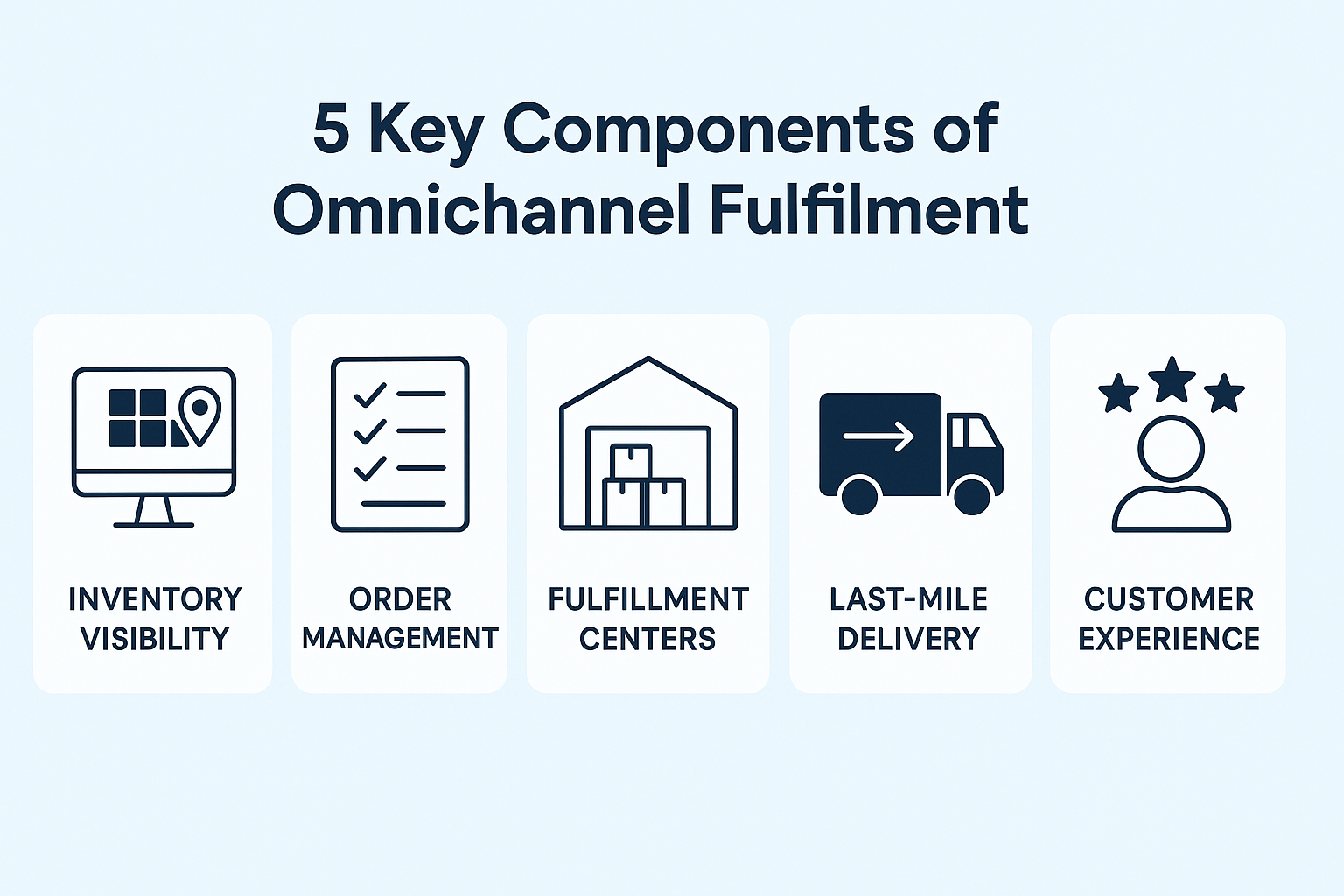Omnichannel Fulfillment Explained: How To Unify Your Sales And Delivery Strategy
The modern consumer doesn’t think in channels—they think in moments. They browse online, check stock on mobile, buy in-store, and expect delivery at their door. For retailers, that means traditional, siloed fulfilment models no longer cut it. Omnichannel fulfilment is the response to this new reality: a unified approach that blends inventory, order processing, and logistics across every touchpoint.
In this guide, we unpack what omnichannel fulfilment really means, explore its operational benefits, and show how you can implement the right strategy to match today’s shopper expectations.
What Is Omnichannel Fulfilment?
Omnichannel fulfilment is the process of managing and delivering orders across multiple channels—online marketplaces, physical stores, brand websites, and mobile apps—through a centralised system. Instead of treating each channel separately, retailers synchronise inventory and coordinate order fulfilment using a shared infrastructure.
This approach ensures that no matter where a customer shops, the backend system can pull from the same pool of inventory, provide real-time stock visibility, and fulfil orders through the most efficient route—whether that’s shipping from a warehouse, local store, or third-party logistics partner.
It’s not just about convenience. Done well, omnichannel fulfilment helps brands optimise delivery costs, reduce stockouts, and improve customer satisfaction.
Why Omnichannel Fulfilment Matters Now
The pressure for speed, convenience, and personalisation in e-commerce has never been higher. Customers expect multiple fulfilment options—click and collect, next-day delivery, in-store pick-up, and even returns at a different location from where they purchased.
At the same time, e-commerce and brick-and-mortar operations can no longer function independently. A customer might browse a product in-store and order it online later, or check online for stock in their local shop. Without an integrated fulfilment system, this behaviour causes friction, missed sales, and wasted stock.
Retailers that adopt omnichannel fulfilment gain several key advantages:
- Real-time inventory visibility across all sales platforms
- Improved order accuracy through centralised order processing
- Reduced shipping costs by fulfilling from the closest location
- Faster delivery times with flexible routing options
- Higher customer satisfaction with consistent service
Multichannel vs Omnichannel Fulfilment: What’s the Difference?
It’s easy to confuse multichannel and omnichannel fulfilment, but they represent two very different operational philosophies.
- Multichannel fulfilment refers to managing each sales channel independently. You may sell through Amazon, your website, and a physical store, but each has its own inventory pool and fulfilment logic.
- Omnichannel fulfilment integrates all those channels into a unified system. Inventory is shared. Orders can be fulfilled from any source. Returns can be processed across channels.
This integration is what enables better decision-making and a smoother customer experience. For example, if a customer orders online and selects click-and-collect, the system checks local store inventory and reserves the product instantly. With a multichannel setup, that might not even be possible.
5 Key Components of Omnichannel Fulfilment

To execute omnichannel fulfilment effectively, several moving parts need to work in sync:
1. Omnichannel Inventory Synchronisation
You need real-time visibility into what’s in stock, where it is, and how fast it’s moving. Centralised inventory management ensures that all sales channels pull from the same data source, helping reduce overselling and prevent stockouts.
2. Centralised Order Processing
Whether the order comes from your Shopify site, Amazon storefront, or an in-store kiosk, your order management system (OMS) should capture, route, and process it in the same way. The system decides the best fulfilment option based on stock availability, customer location, and shipping cost.
3. Flexible Fulfilment Options
A key strength of omnichannel is giving customers choice. Ship from store, click and collect, local delivery, or warehouse dispatch—your fulfilment network should support each option without creating operational chaos.
4. Integrated Returns Handling
Returns shouldn’t be a headache. Customers expect to return items through any channel. That means your returns process should be visible across systems, whether the return is dropped at a store or posted back to a warehouse.
5. Unified Customer Data
Centralising customer data allows you to deliver a consistent experience across platforms. If a customer has purchased online before, store associates should be able to see their profile, past orders, and preferences.
Omnichannel Fulfilment Strategy: How to Get It Right
Building an omnichannel fulfilment strategy requires more than just software. It involves aligning people, processes, and partners to support seamless operations.
Common Challenges in Omnichannel Fulfilment
While the benefits of omnichannel fulfilment are compelling, achieving seamless execution isn’t easy. Brands often underestimate the complexity involved in syncing multiple sales and logistics channels under one roof.
Here are the most common issues retailers face—and how to overcome them.
1. System Integration and Data Silos
Most businesses don’t start with a perfectly integrated tech stack. Legacy systems, manual processes, and poor API connections result in fragmented data across platforms.
- What this looks like: Your POS shows a product in stock, but your online store says it’s unavailable. Your returns system doesn’t notify the warehouse to restock items promptly.
- Fix: Invest in middleware or a centralised OMS that bridges all major platforms (WMS, ERP, POS, e-commerce, CRM). Prioritise real-time data syncs over batch updates.
2. Inventory Inaccuracies
When inventory data is delayed or unreliable, overselling and backorders become common. This not only frustrates customers but also increases refund and support costs.
- Causes: Human error in stock logging, delayed warehouse scans, or inconsistent SKU naming across channels.
- Solution: Implement barcode scanning and RFID where possible, automate updates at every touchpoint, and run weekly audits of high-turnover products.
3. Complex Reverse Logistics
Returns are inherently more complicated in omnichannel fulfilment. Customers may buy online and return in-store—or vice versa—and your system needs to accommodate all possible flows.
- Issue: Returned items get lost, refunds are delayed, or restocking is slow, leading to dead inventory and customer dissatisfaction.
- Mitigation: Use a returns portal that links with your OMS. Label each item with a return reason, track location, and log conditions on re-entry.
4. Inconsistent Last-Mile Delivery
Offering fast delivery is one thing—actually doing it reliably across different geographies is another. When you rely on a mix of in-house and third-party couriers, consistency suffers.
- Impact: Delayed deliveries, tracking errors, or packages delivered to the wrong address.
- Action: Choose regional logistics partners with SLA guarantees. Integrate delivery tracking directly into your customer emails and support tools.
5. High Upfront Investment
Implementing omnichannel fulfilment can mean investing in new systems, retraining staff, and reworking existing logistics contracts. For smaller businesses, this cost can feel like a barrier.
- Typical expenses: OMS software, API development, WMS upgrades, additional headcount during rollout.
- Way forward: Start with a limited pilot. Prove ROI in one region or product line, then roll out wider changes in stages. Focus first on areas that reduce costs—like smarter inventory usage or store-based shipping.
6. Misaligned KPIs Across Departments
If your warehouse team is measured on speed, but your support team is judged on customer satisfaction, they may end up working at cross-purposes. Omnichannel fulfilment only works when departments share common goals.
- Example: Warehouse skips quality checks to hit a shipping target, but the result is more returns and angry support calls.
- Fix: Align fulfilment, support, and sales teams around shared performance indicators—like return rate, first-attempt delivery success, or fulfilment cost per order.
Bezos: Fulfilment-as-a-Service Built for Scale

Bezos offers a modern fulfilment solution for ecommerce businesses, enabling brands to sell globally and deliver locally through its network of 63 fulfilment centres across 16 countries.
- Multichannel Integration: The platform syncs with over 30 online sales channels—Shopify, Amazon, eBay, WooCommerce, Etsy, Wayfair—so orders from multiple platforms are captured and managed centrally.
- AI-Optimised Routing: Leveraging AI, orders are intelligently routed to the optimal fulfilment centre based on inventory location, shipping cost, and delivery time.
- Real-Time Transparency: Their custom portal provides live updates on stock, order status, and delivery progress. This visibility has reportedly reduced incoming support tickets by 46%.
- Dedicated Support: Each client receives a personal account manager with a ~2-hour ticket response time, offering consistent support and clarity throughout the fulfilment cycle.
- Flexible & No Minimums: Bezos operates on a “pay-as-you-go” basis—no monthly fees or volume commitments—making it accessible for small to mid-sized sellers looking to scale.
In summary, Bezos brings together technology, logistics expertise, and global infrastructure into one accessible fulfilment platform. It lets ecommerce brands deliver faster, reduce costs, and support omnichannel operations—all without complex integrations or long-term commitments.
Ready to Simplify Your Fulfilment?
If you’re looking to scale your ecommerce operations without the logistical headaches, Bezos offers a smarter, faster way to fulfil orders across multiple channels. Get started today and see how fulfilment-as-a-service can free up your time, lower your costs, and keep your customers coming back. Get a quote today!
Conclusión
Omnichannel fulfilment isn’t a luxury anymore—it’s a competitive necessity. As customer expectations grow sharper and more fragmented, brands that unify their sales and delivery infrastructure are far better positioned to meet demand, reduce costs, and retain loyalty.
With solutions like Bezos and others making advanced logistics more accessible than ever, the path to true omnichannel success is no longer reserved for the giants. It's operational, achievable—and well within reach. Get a quote today!
Preguntas frecuentes
What is the meaning of omnichannel fulfilment?
Omnichannel fulfilment is the process of managing and delivering customer orders across multiple sales channels—such as websites, marketplaces, and physical stores—through a unified system. It allows retailers to pull from shared inventory, route orders intelligently, and provide consistent experiences no matter where the purchase happens. The goal is to improve speed, accuracy, and convenience across all touchpoints.
What is Omni Fulfilment?
Omni fulfilment is another term for omnichannel fulfilment. It refers to the coordinated handling of inventory, order processing, and delivery across online and offline channels. With omni fulfilment, customers can buy online, pick up in store, or return items through any channel, all supported by an integrated backend system.
What are the 4 C's of omnichannel?
The 4 C’s of omnichannel typically refer to Consistency, Convenience, Customer-centricity, and Communication. These principles guide how retailers deliver a seamless and cohesive experience across all channels. Each “C” ensures that interactions—whether online, in-store, or via mobile—are aligned, easy, and focused on customer needs.
As a part of the Bezos.ai team, I help e-commerce brands strengthen their fulfilment operations across the UK, Germany, the Netherlands and the US. I work with merchants that want to simplify logistics, reduce costs and expand into new markets. I’m also building my own e-commerce brand, which gives me practical insight into the challenges founders face. In my writing, I share fulfilment strategies, growth lessons and real-world advice drawn from both sides of the industry.












